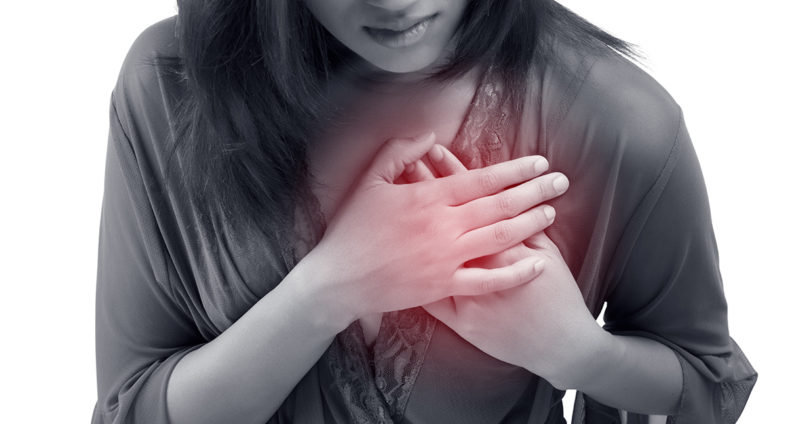Heart disease remains one of the leading causes of death worldwide, and its impact on women is particularly profound. Often, the signs and symptoms of heart blockage in females can be subtle, differing from the more recognized symptoms in males. This makes it crucial for women to be aware of the nuances in symptoms to protect against the potential risks of cardiovascular health issues.
Understanding these signs is the first step toward prevention and ensuring a healthy heart. Recognizing the symptoms early can lead to prompt diagnosis and treatment, ultimately saving lives.
Understanding Heart Blockages in Females:
Definition of Heart Blockage:
Heart blockage, known medically as coronary artery disease (CAD), involves the narrowing or blockage of the coronary arteries, the blood vessels that supply blood to the heart itself. This condition primarily results from the buildup of fatty plaques in these arteries, a process known as atherosclerosis. Over time, this buildup can reduce or even completely obstruct the flow of oxygen-rich blood to the heart muscle, leading to various heart-related symptoms and conditions, including heart attacks. Understanding this definition is crucial in recognizing the significance of identifying and addressing heart blockage symptoms, especially in females, who may experience these signs differently than men.
Gender-specific Differences in Heart Disease
Research has shown that women often experience and report heart disease symptoms differently than their male counterparts. While both men and women can experience the classic signs of heart attack, such as chest pain and discomfort, women are more likely to describe their pain as a pressuring or squeezing sensation rather than the often-cited “sharp” or “stabbing” pain. Moreover, females are also more prone to exhibit symptoms unrelated to chest pain, such as fatigue, nausea, and shortness of breath. These differences highlight the importance of gender-specific approaches to diagnosing and treating heart disease.
Common Symptoms of Heart Blockage in Women:
Chest Discomfort
Chest discomfort is one of the most common signs of heart blockage in women; however, the nature of this discomfort can vary significantly from the traditional “elephant sitting on the chest” feeling. Women are more likely to describe it as a tightness or pressure in the center of the chest rather than acute pain. This sensation might not be constant—it can come and go and is sometimes mistaken for indigestion or heartburn.
Shortness of Breath
Experiencing shortness of breath doing activities that used to be easy or even at rest can be a subtle but significant sign of heart blockage in women. This symptom can occur without chest pain and might be mistakenly attributed to being out of shape or overweight. However, when the heart isn’t receiving enough oxygen because of a blockage, it can struggle to pump blood efficiently, leading to this breathless feeling.
Fatigue
Unexplained fatigue is another frequently reported symptom among women with heart blockages. This isn’t just feeling tired after a busy day; it’s an overwhelming fatigue that can’t be alleviated with rest. Some women describe feeling extremely worn out doing tasks that were previously manageable, such as making the bed, walking to the mailbox, or standing up for some time.
Nausea or Vomiting
While nausea and vomiting might be more commonly associated with gastrointestinal issues, they can also be symptoms of heart blockage in women. This is especially true when these symptoms are paired with other signs like chest discomfort, shortness of breath, or fatigue. Women might dismiss these symptoms as the flu or stress, not realizing they could indicate a serious heart issue.
Identifying these symptoms early and seeking medical advice is crucial for women to protect against cardiovascular risks. Awareness of the subtle signs of heart blockage can be life-saving, as it enables earlier intervention and treatment, potentially preventing severe heart disease outcomes.
Subtle Signs of Heart Blockage in Females:
Heart disease is a leading cause of death among women, but its symptoms are often different and more subtle compared to those experienced by men. Understanding these can be crucial for early detection and treatment. Let’s discuss some of these subtle signs that might suggest the presence of heart blockage in females.
Jaw, Neck, or Shoulder Pain
An unexpected sign of heart blockage in females is pain in the jaw, neck, or shoulders. This discomfort is not always intense and can be mistaken for tension, stress, or muscle strain. However, if the pain appears without any obvious physical cause, especially when combined with other symptoms, it may be a signal of heart trouble. The pain might come and go, but its persistence or occurrence with activities that increase the heart’s workload warrants medical attention.
Back Pain
Back pain, particularly in the lower back, can be another hint of heart blockage in females. It might feel like a pressurized or burning sensation. Women often overlook this symptom, attributing it to poor posture, physical strain, or minor injuries. Yet, if the pain persists without a clear reason, especially if it’s accompanied by other signs of heart problems, it should not be ignored.
Dizziness or Lightheadedness
Feeling dizzy or lightheaded can occur for a variety of reasons, including dehydration or sudden changes in position. However, when these sensations are coupled with chest discomfort or shortness of breath, they may indicate a heart blockage. This happens because the heart is struggling to pump blood efficiently, leading to decreased blood flow to the brain and other parts of the body.
Arm Pain
Arm pain, particularly in the left arm, though it can affect both arms, is a renowned sign of heart attack in men, but it’s also relevant for women. The pain might not be limited to the arm; it could spread from the chest to the arms and is often described as a squeezing or aching feeling. Unlike typical muscle pain, which is localized and can be pinpointed, this pain tends to be more generalized.
Risk Factors for Heart Blockages in Women:
Certain factors may increase the risk of developing heart blockages in women. Knowing these can help in taking preventive steps to maintain cardiovascular health.
Age
As women age, their risk of heart disease increases, particularly after menopause. This risk grows due to changes in hormone levels, especially a drop in estrogen, which is believed to offer some protection against artery and heart diseases.
Lifestyle Choices
Lifestyle choices play a significant role in the risk of developing heart blockages. Smoking, lack of physical activity, a diet high in saturated fats and sugars, and excessive alcohol consumption can all contribute to cardiovascular issues. Adopting a healthier lifestyle can significantly reduce these risks.
Family History
A family history of heart disease can increase a woman’s risk of heart blockages. If close relatives have had heart disease, it’s important to discuss this with a healthcare provider, as it might necessitate earlier or more frequent screening.
Other Health Conditions
Other health conditions such as high blood pressure, diabetes, high cholesterol, and obesity are significant risk factors for heart disease. Managing these conditions with the help of healthcare providers can minimize the risk of developing heart blockages. Maintaining a healthy weight, regular exercise, and following a heart-healthy diet are crucial steps in this direction.
Understanding the subtle signs of heart blockage and recognizing risk factors are essential for women to protect against cardiovascular risks. Early detection and lifestyle adjustments can make a significant difference in heart health.
Diagnosis and Treatment Options for Heart Blockage in Females:
Diagnostic Tests
To diagnose heart blockage in females, healthcare professionals employ a variety of tests. An Electrocardiogram (ECG) monitors the heart’s electrical activity, helping to identify any irregularities. An Echocardiogram uses sound waves to produce images of the heart, which can reveal areas of poor blood flow. Stress tests, which monitor the heart’s performance during physical activity, and Cardiac catheterization, where a thin tube is inserted into a blood vessel leading to the heart to take pictures and measure pressure, are also pivotal. Additionally, Blood tests can identify certain enzymes that leak into the blood when the heart is damaged.
Medications
Medications are often the first line of treatment for heart blockage. These can include cholesterol-lowering drugs, such as statins, to decrease the buildup of plaques in the arteries. Antiplatelet drugs and anticoagulants help prevent blood clots, a primary cause of heart attacks. Beta-blockers and angiotensin-converting enzyme (ACE) inhibitors are used to lower blood pressure and reduce heart strain.
Procedures and Surgeries
In more severe cases, procedures and surgeries can be necessary. Angioplasty involves using a balloon to open narrowed or blocked arteries followed by the placement of a stent to keep the artery open. Coronary Artery Bypass Grafting (CABG) is a more invasive surgery that reroutes the blood around a blocked artery. Both procedures aim to restore normal blood flow to the heart.
Lifestyle Changes
Adopting a heart-healthy lifestyle is crucial for managing and preventing further heart blockage. This includes eating a balanced diet low in saturated fats, cholesterol, and sodium while high in fruits, vegetables, and whole grains. Regular physical activity, aiming for at least 150 minutes of moderate exercise per week, is recommended. Other significant changes include quitting smoking, reducing alcohol consumption, managing stress, and controlling other conditions such as diabetes, high blood pressure, and obesity, all contributing to cardiovascular health.
Prevention and Lifestyle Tips for Cardiovascular Health in Women:

Maintaining a heart-healthy lifestyle is crucial for women to reduce the risk of heart blockage and other cardiovascular diseases. Here are key areas to focus on:
Healthy Diet
Eating a diet rich in fruits, vegetables, whole grains, and lean proteins can significantly improve cardiovascular health. Limiting the intake of saturated fats, sugars, and salt is also important. Including heart-healthy fats from sources like avocados, nuts, and olive oil can provide added benefits. A balanced diet supports healthy blood pressure and cholesterol levels, which are vital in preventing heart blockage.
Regular Exercise
Regular physical activity is essential for maintaining a healthy heart. Aim for at least 150 minutes of moderate aerobic exercise or 75 minutes of vigorous exercise each week, as recommended by health experts. Activities such as walking, swimming, cycling, or running can boost heart efficiency, improve blood circulation, and help manage weight, reducing the risk of heart disease.
Stress Management
Chronic stress is a known risk factor for heart disease. Implementing stress reduction techniques such as meditation, yoga, deep breathing exercises, and mindfulness can help lower stress levels and improve overall cardiovascular health. Finding hobbies or activities that relax and rejuvenate the mind can also play a crucial role in managing stress effectively.
Regular Health Check-ups
Regular check-ups with a healthcare provider are vital for early detection and management of cardiovascular risk factors. These include monitoring blood pressure, cholesterol levels, and blood sugar levels. Women should discuss with their doctor how often they need to be screened based on their health history, age, and overall risk factors. Staying proactive about health can lead to early intervention and prevention of heart blockage and other serious heart conditions.
